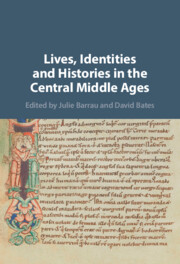Book contents
- Lives, Identities and Histories in the Central Middle Ages
- Lives, Identities and Histories in the Central Middle Ages
- Copyright page
- Contents
- Figures
- Contributors
- Abbreviations
- Introduction
- Part I Entwined Lives and Multiple Identities
- 1 Mother and Motherhood in the Vita et Passio Willelmi Norwicensis
- 2 Prayer for the Dead:
- 3 Authority over Men and the Allocation of Riches:
- 4 Flemish Settlement and Maritime Traffic in the South-West Peninsula of Britain, c. 1050–1250
- 5 Cistercians and the Laity in Twelfth- and Thirteenth-Century Upper Normandy
- 6 Memory and Trauma:
- 7 New Charters of the Empress Matilda, with Particular Reference to Her Reception at Gloucester in 1139
- 8 Female Identity before 1250:
- Part II Historians, Lawyers and Exegetes: Writing Lives and Identities
- Index
2 - Prayer for the Dead:
Women, Death and Salvation
from Part I - Entwined Lives and Multiple Identities
Published online by Cambridge University Press: 24 September 2021
- Lives, Identities and Histories in the Central Middle Ages
- Lives, Identities and Histories in the Central Middle Ages
- Copyright page
- Contents
- Figures
- Contributors
- Abbreviations
- Introduction
- Part I Entwined Lives and Multiple Identities
- 1 Mother and Motherhood in the Vita et Passio Willelmi Norwicensis
- 2 Prayer for the Dead:
- 3 Authority over Men and the Allocation of Riches:
- 4 Flemish Settlement and Maritime Traffic in the South-West Peninsula of Britain, c. 1050–1250
- 5 Cistercians and the Laity in Twelfth- and Thirteenth-Century Upper Normandy
- 6 Memory and Trauma:
- 7 New Charters of the Empress Matilda, with Particular Reference to Her Reception at Gloucester in 1139
- 8 Female Identity before 1250:
- Part II Historians, Lawyers and Exegetes: Writing Lives and Identities
- Index
Summary
This chapter highlights women’s roles in medieval death practice, arguing that women’s traditional care for the dying and dead and their social role as mourners were consistent with, and in fact fundamental to, the spiritual role of nuns as valued intercessors. As custodians of family memory, women were central to medieval remembering; however, nuns have typically been seen as marginal to the monastic practices of liturgical memoria – the ritualized prayer for the dead that is generally thought to have become the specialised work of ordained monks by the Central Middle Ages. Focusing on the commemorative and intercessory roles of women as wives and mothers, the place of women in biblical narratives of the Passion and Resurrection and the social and spiritual contributions of female monasticism, this chapter argues that women’s ties to death, as both a practical and a spiritual matter, provided nuns with a central and valued role in medieval memorial practice and intercessory prayer.
- Type
- Chapter
- Information
- Publisher: Cambridge University PressPrint publication year: 2021
- 2
- Cited by

